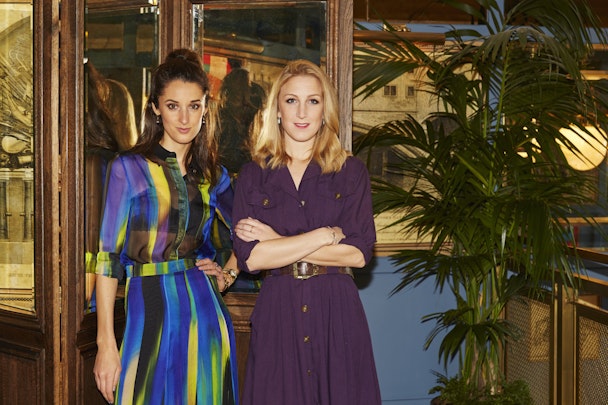Q&A: FashMash founders discuss how retailers can survive the digital revolution
Isobar UK's Alex Hamilton spoke to FashMash founders Rosanna Falconer and Rachel Arthur about the impact the digital revolution is having on retail and how the store will have to evolve to survive.

Founders of Fash Mash Rosanna Falconer and Rachel Arthur
It’s not so long ago that any transactional exchange between customer and retailer happened in a brick and mortar store. The internet changed all that.
Nowadays, consumers can choose from a host of different channels to engage with and buy from a brand. One consequence of this seismic shift is that store targets set against historical KPIs such as sales and footfall are becoming harder to achieve.
Moreover, brands are starting to realise that traditional retail models from an analogue age are moving further and further away from current consumer expectations of the shopping experience.
We are witnessing a digital revolution of incredible speed. If traditional brick and mortar stores are to emerge unscathed from this disruption, the store of the future will very quickly have to become the store of the present.
There’s a lot of attention on the death of the store. What do retailers need to do to reinvent that experience?
Rosanna Falconer: For me, the fundamental ingredients for a great store are the same now as they were 50 years ago: excellent customer service tailored to each customer, their tastes and their needs.
The digital revolution might make it tempting for retailers to think that integration of tech into their brick and mortar store is the most obvious fix for a fall in footfall; but really, customers are going to keep returning to a store for the human connection and incomparable level of service.
Today’s customer is more demanding than ever so stores have to step up to meet these expectations. Then, of course, once the right staff have been recruited, the priority is to ensure diligent use of the appropriate technology to make their roles easier and the customer experience seamless.
Rachel Arthur: As Rosanna said, service is at the heart of retail in the same way now as it’s always been. What’s shifted, however, is consumer expectation. Today, because of digital and specifically our own mobile phones, we’re used to getting anything and everything we want at the touch of a button or the swipe of a finger.
Today’s retail experience, therefore, has to be just as seamless. It has to be convenient and increasingly frictionless in order just to reach the minimum level of acceptability for the so-called ‘instant gratification’ generation. It’s for that very reason, however, that stores also need to think about the reasons why people are attracted to physical spaces.
The very nature of this transactional approach to shopping is driving a simultaneous desire for human touch and experience in a way that wasn’t there before – a desire for something more tangible driven by a demand for entertainment, education and community.
Are there any great examples of retailers bringing digital in store?
RF: Last year, John Lewis unveiled their new partner app as part of a multichannel retail drive. I love the way it empowered its shop floor staff - a group who might increasingly feel threatened by e-commerce domination.
The app means they can quickly provide information about products and stock availability, and place orders. I was on the judging panel for the Drapers Digital Awards this year and we awarded Missguided with the award for best in store innovation for their flagship in Bluewater.
They know and love their millennial audience and wanted to create “the most instagrammable store in the world” to appeal to them. Queue unicorns, motivational quotes and a festival-style atmosphere throughout just beg to be snapped and shared on customers’ social media feeds, which helps spread the word about the store. It’s an immersive brand experience.
RA: Right at the heart of the digital transformation of the store are those brands thinking about how to combine frictionless shopping with content, discovery and experience.
Someone like Sephora, for instance, achieve all of this with educational training both in store and online. Apple, meanwhile, is a brand that is constantly thinking about driving a sense of community through the moments it creates in its spaces. The direction of travel, however, is around offering more personalised experiences – a drive for individual and tailored moments facilitated through next level CRM tools as per the store of the future.
What is the store of the future from the brand perspective?
RF: Any brand thinking about the future of their retail offer needs to consider their unique values and customer. One solution will not be right for all.
RA: The store of the future is about driving customer engagement and loyalty in a way that hasn’t been achieved since before the first industrial revolution.
Back then, boutiques knew their shoppers individually by name, tastes, purchase behaviour and more – it was all about personal relationships on a one-to-one level. Over the years, we’ve inevitably moved into volume and price-driven retail, enabled by our own technological evolution.
Now, in the midst of Industry 4.0, we’re coming full circle. Data sits at the heart of this with the potential for new CRM tools to bring us back to that individual and personalised experience, except this time at scale. The store of the future isn’t therefore about smart mirrors or gimmicky tech that we all think the customer today might want; it’s about driving relevancy. And it’s doing so by focusing on making the physical store as intelligent as the online one by the (opt-in) data it gathers. Farfetch calls this ‘enabling the offline cookie’.
Alex Hamilton, head of insight, Isobar UK

